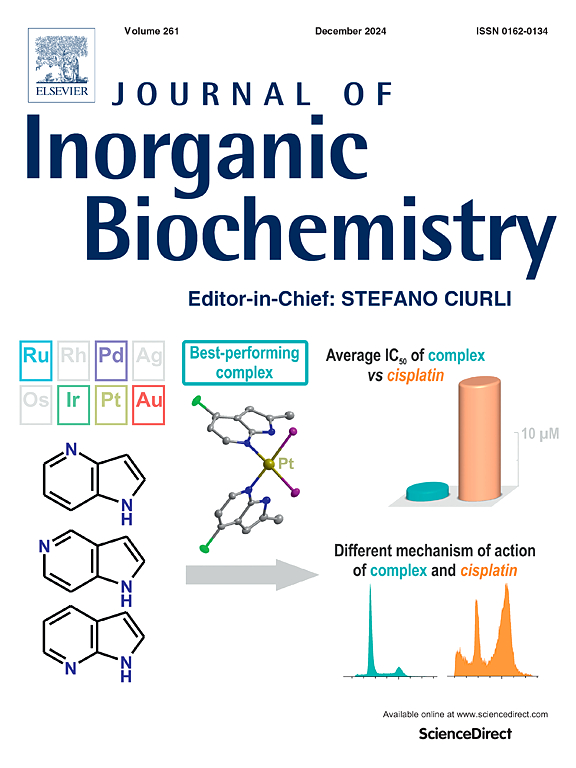Reinvestigation of the mechanism of dioxygen activation at a MnII(cyclam) center
IF 3.8
2区 化学
Q2 BIOCHEMISTRY & MOLECULAR BIOLOGY
引用次数: 0
Abstract
This study deals with the unprecedented reactivity of a [(cyclam)MnII(OTf)2] (3-cis; OTf = CF3SO3−) with O2, which, depending on the presence or absence of a hydrogen atom donor like 1-hydroxy-2,2,6,6-tetramethyl-piperidine (TEMPO-H), selectively generates di-μ-oxo Mn(III)Mn(IV) (1) or MnIV2 (2) complexes, respectively. Both dimers have been characterized by different techniques including single-crystal X-ray diffraction, X-ray absorption spectroscopy, and electron paramagnetic resonance. Oxygenation reactions carried out with labeled 18O2 and Resonance Raman spectroscopy unambiguously show that the oxygen atoms present in the MnIVMnIII dimer originate from O2. Experimental evidences are provided for a novel method of dioxygen activation involving three Mn ions or two Mn ions and TEMPO-H to generate the bis(μ-oxo)dimanganese(IV) or bis(μ-oxo) dimanganese(III, IV) cores, respectively.

MnII(cyclam)中心双氧活化机制的再研究。
本文研究了a [(cyclam)MnII(OTf)2] (3-cis;OTf = CF3SO3-)与O2反应,根据是否存在像1-羟基-2,2,6,6-四甲基哌啶(TEMPO-H)这样的氢原子供体,分别选择性地生成di-μ-oxo Mn(III)Mn(IV)(1)或MnIV2(2)配合物。这两种二聚体都用不同的技术进行了表征,包括单晶x射线衍射、x射线吸收光谱和电子顺磁共振。用标记的18O2和共振拉曼光谱进行的氧化反应明确地表明,MnIVMnIII二聚体中的氧原子来自O2。实验证明,采用3个Mn离子或2个Mn离子和TEMPO-H分别生成双(μ-oxo)二锰(IV)或双(μ-oxo)二锰(III, IV)核的双氧活化新方法是可行的。
本文章由计算机程序翻译,如有差异,请以英文原文为准。
求助全文
约1分钟内获得全文
求助全文
来源期刊

Journal of Inorganic Biochemistry
生物-生化与分子生物学
CiteScore
7.00
自引率
10.30%
发文量
336
审稿时长
41 days
期刊介绍:
The Journal of Inorganic Biochemistry is an established international forum for research in all aspects of Biological Inorganic Chemistry. Original papers of a high scientific level are published in the form of Articles (full length papers), Short Communications, Focused Reviews and Bioinorganic Methods. Topics include: the chemistry, structure and function of metalloenzymes; the interaction of inorganic ions and molecules with proteins and nucleic acids; the synthesis and properties of coordination complexes of biological interest including both structural and functional model systems; the function of metal- containing systems in the regulation of gene expression; the role of metals in medicine; the application of spectroscopic methods to determine the structure of metallobiomolecules; the preparation and characterization of metal-based biomaterials; and related systems. The emphasis of the Journal is on the structure and mechanism of action of metallobiomolecules.
 求助内容:
求助内容: 应助结果提醒方式:
应助结果提醒方式:


